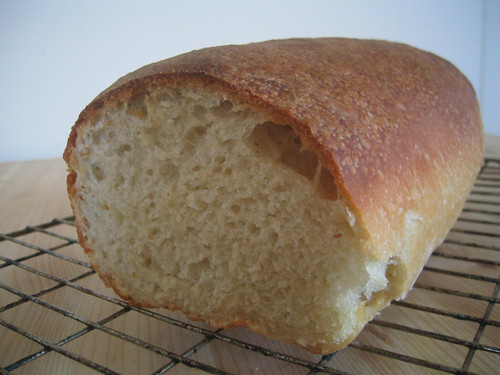I decided to start a blog to keep a log of my baking and hopefully get some feedback on my efforts. Rather than start by driveling on about how long I've been baking for etc. (plenty of time for that). I think I'll get straight on to posting this mornings efforts.

It's a sourdough Pagnotta from 'BAKER & SPICE: exceptional breads' by Dan Lepard & Richard Whittington. I changed three things from the original recipe: more water; the 800g total flour to 325ml total water seemed to dry to me so I upped the water to 400ml, proved overnight at cold room temp and I proved and baked it in the same oiled silicon loaf mould. I think the texture of this loaf is superb, hard crispy crust but with a light and soft crumb. The flavour is mild enough for me AND sourdoughphobic housemates to enjoy. The only thing I didn't like was the crust was a little oily on the sides in contact with the loaf mould and without a proving basket I'm strungling to think of another way to help keep the batons shape over the long slow prove. Any ideas?
This is my first blog entry (on TFL or any site for that matter) so critisicm, feedback or praise both of the blog and the bread is very welcome.
- overnight baker's Blog
- Log in or register to post comments
You are off to a great start with your blog and I like the bread, too. Sounds like a good decision to bump the hydration a bit higher; the results certainly look good.
Are you acquainted with a couche? Nope, it isn't a piece of furniture. It's a piece of fabric; linen works best but cotton is perfectly serviceable. Some people even use canvas or duck. Yes, I know it's April Fool's day and no, I'm not talking about waterfowl or wine. Do stay away from terry cloth, though. The secret is to rub flour into the weave of the fabric so that the fabric becomes "saturated" with the flour. Some people use all purpose flour, others prefer a 50/50 blend of all purpose and rice flours. The flour serves to keep the dough from sticking to the cloth. Use the search function here on TFL or google the term; you are bound to find both descriptive text and photos. The idea is to use the couche to support the shaped batards / batons / baguettes / ficelles and help them maintain their shape as they ferment, prior to baking. That eliminates any possibility of the dough absorbing grease from the pan, as you have described.
Hope that helps.
Paul
Thanks for your advice. I'd been told something similar before but hadn't had much success as the bread always deflated as I tried to unstick it from the fabric I think my problem was that I was lightly dusting it in flour and not,
I shall give this a try
Paul's advice will definitely help you solve your shaping problem. Before I had a couche I used to proof on parchment paper, and I'd roll up a couple tea towels and place them under the paper on each side of the loaf to allow it to rise up rather than out.
Also, when shaping it helps if you can achieve a tight seam that creates some surface tension in the dough without deflating it.
I look forward to seeing more of your bakings-
Larry